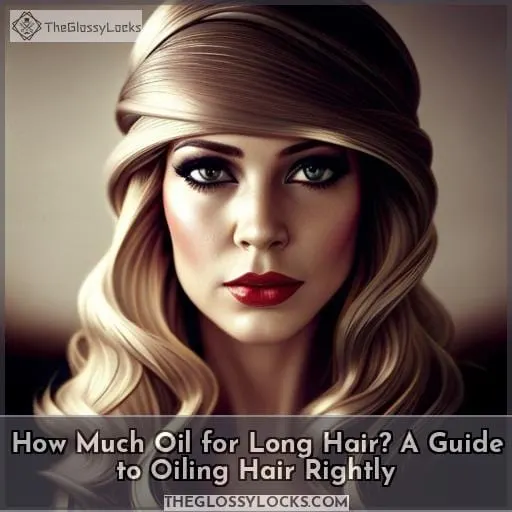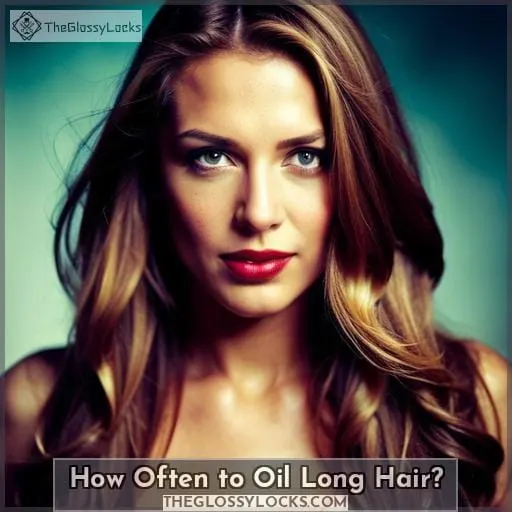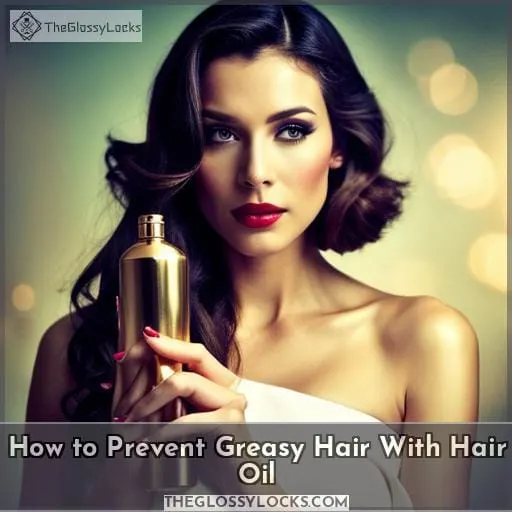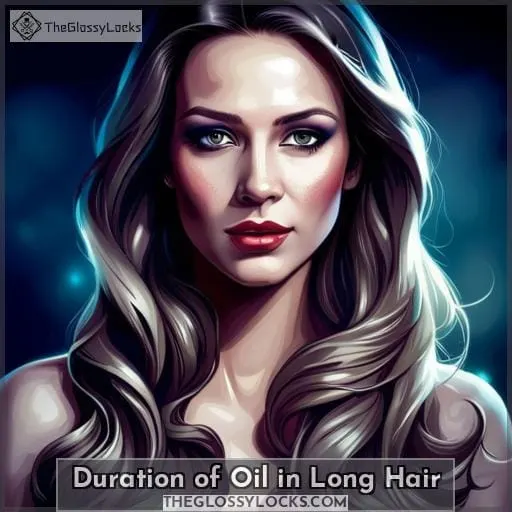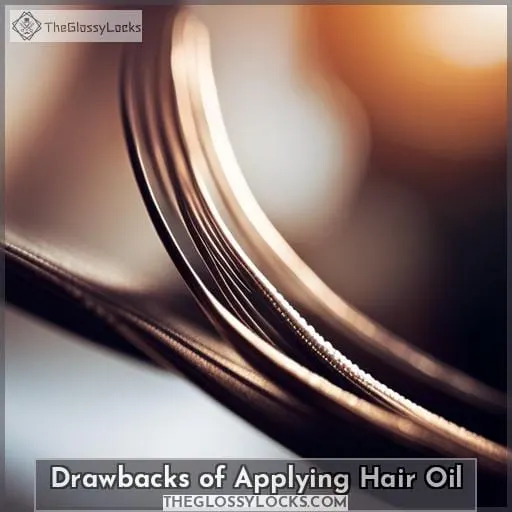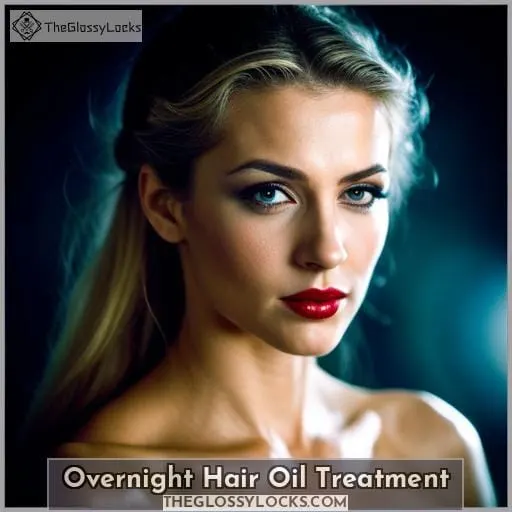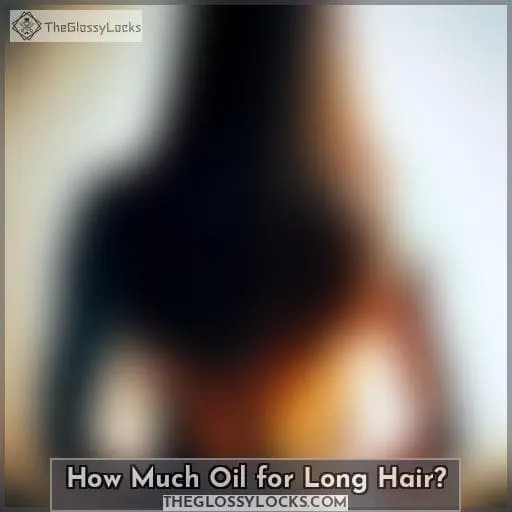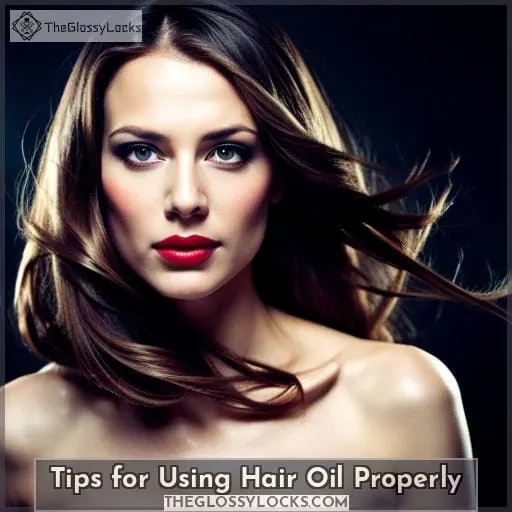This site is supported by our readers. We may earn a commission, at no cost to you, if you purchase through links.
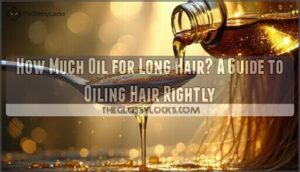 Wow! Oiling hair is a must-do for those with long locks, but how much oil do you need? How often should it be applied and what are the best practices to avoid greasy hair?
Wow! Oiling hair is a must-do for those with long locks, but how much oil do you need? How often should it be applied and what are the best practices to avoid greasy hair?
In this article, we will answer all of your burning questions about oiling long hair. From benefits to drawbacks and everything in between – let’s dive into the right way of using oil for gorgeous tresses.
So if you want to know how many ounces of oil do I need for my long mane, keep reading as I guide you through the art of proper haircare with oils!
Table Of Contents
Key Takeaways
- The amount of oil needed for long hair depends on its length and texture.
- Straight hair requires less oil compared to curly or wavy hair.
- It is recommended to apply oil only to the mid-lengths to tips if you have oily roots and dry ends.
- Using the right amount of oil for your hair type is essential to avoid greasiness or wastefulness.
How Often to Oil Long Hair?
You can give your long locks a luxurious sheen with regular oil treatments! Oiling your hair is one of the most important steps for maintaining healthy, beautiful tresses. It helps to protect against split ends and breakage, while also providing nourishment that promotes hair growth.
Depending on the type of oil you use and how often you massage it into your scalp, this treatment could be just what’s needed to keep frizz at bay as well as provide heat protection from styling tools like curling irons or blow dryers.
The amount of oil needed depends largely on the length and texture of your hair. Those with straighter types usually need less than those who have coarser curls or waves because their strands require more moisture retention to stay hydrated.
If you have oily roots but dry ends (which is common among people with longer manes), start by applying an appropriate amount only onto mid-lengths down through tips. These areas are prone to becoming brittle over time due to a lack of natural oils being produced at the root level where our body produces sebum naturally from follicles.
This way will help prevent buildup near the scalp without compromising overall healthiness throughout lengths when using lighter formulas such as sweet almond, coconut, argan, jojoba, etc.
With any kind of haircare routine, though, it’s always best practice not to go overboard! Too much product can cause unwanted greasiness, so experiment until you find the right balance between keeping things moisturized without going too far.
Benefits of Oiling Hair
Oiling your hair can give it a glossy, luxurious shine – like pouring liquid silk through each strand.
From protecting against split ends to promoting growth and scalp health, adding moisture is essential in any haircare routine.
You don’t need much product either. Depending on the type of oil you use, as well as the length and texture of your hair, it will determine how much or little you should apply. For instance, if you have oily roots but dry ends, then an appropriate amount should be applied from mid-lengths down through tips.
These areas tend to become brittle over time due to the lack of natural oils being produced at the root level, where our body produces sebum naturally from follicles.
Some popular types include coconut oil, olive oil, or jojoba, which all work wonders when combined with other ingredients such as honey or yogurt for extra nourishment!
Heat styling tools like curling irons may take away moisture, so using an intensely hydrating formula before blow-drying will help protect strands while locking in hydration longer than just air drying alone would do.
This way, preventing frizzy flyaways that come along after heat styling has been done without proper care beforehand! And if greasiness is something one wishes to avoid altogether, then experiment until finding the right balance between keeping things moisturized without going overboard.
Results usually last several days after wash day, meaning reapplication isn’t necessary every single time showering happens, making it easier to sustain a healthier-looking style overall.
Finally, by incorporating regular treatments into a weekly beauty regimen, not only can breakage and split ends be avoided, but long locks get treated with the special attention they deserve, giving them life back again to enjoy their full potential no matter what environment surrounds us!
How to Prevent Greasy Hair With Hair Oil
When it comes to caring for long hair, oil is essential. Whether you’re looking for a glossy finish or want to protect your strands from breakage and split ends, natural oils can do wonders.
The key lies in finding the right balance between keeping things moisturized without going overboard. A good starting point would be choosing the best type of oil according to one’s hair texture and length – such as coconut oil, olive oil, or jojoba.
Then, experiment until finding the perfect combination with other ingredients like honey or yogurt for extra nourishment while avoiding excessive buildup on the scalp area.
A weekly massage with these products should also help stimulate circulation to achieve better results. To make sure none of those pesky flyaways appear after heat styling tools have been used — which may take away moisture — using an intensely hydrating formula before blow-drying will help protect tresses against any damage done by high temperatures while still locking in hydration longer than air drying alone would do.
When it comes down to obtaining maximum benefits from these treatments, here are a few tips:
- Make sure not to overuse the product; use just enough so that each strand receives equal amounts without having leftovers dripping off onto clothing items afterwards.
- Use organic oils instead since they come free from harmful chemicals often found in synthetic varieties.
- Pay special attention to ensuring different lengths receive varying quantities accordingly (for instance, oily roots but dry ends). Plus, adding essential oils can give them some extra fragrance alongside their new shine!
Finally, keep everything clean by washing off excess residue every few days with a gentle sulfate-free shampoo made specifically designed castor-based formulas. This will ensure scalp health stays intact even after multiple uses over time, offering beautiful locks everyone deserves to enjoy all year round, no matter what environment surrounds us today, tomorrow, or later down the line.
Duration of Oil in Long Hair
To maintain healthy and lustrous locks, strike the right balance between nourishing your hair with oil while avoiding greasiness. Knowing how much oil is needed for long hair starts by having a good understanding of your hair type and length.
This will help you determine which types of oils are best for providing scalp nourishment without weighing down strands or making them appear too oily.
Generally speaking, heavy oils like coconut or olive should be used sparingly as they may leave residue behind even after washing. Humectants such as jojoba are better options when it comes to adding moisture retention without overdoing it on product buildup in the process.
When applying any kind of oil treatment to long locks, make sure not to douse every strand from root to tip but target specific areas that need more attention instead (i.
Further optimize results by giving yourself weekly massages with natural ingredients like honey or yogurt alongside essential oils. This will stimulate circulation within roots so nutrients can reach tresses quicker than usual — resulting in shiny, voluminous manes everyone dreams about achieving during these days at home! Keep everything clean though: rinse off excess residue every few days using sulfate-free shampoos designed specifically for castor-based formulas to prevent buildup from accumulating over time — leading towards beautiful results each day we continue taking excellent care our beloved crowns deserve all year round regardless of what environment surrounds us today, tomorrow, or later on down the line.
Drawbacks of Applying Hair Oil
Applying excess oil to long hair can have drawbacks, such as leaving residue behind after washing and weighing down strands. Additionally, too much oil can lead to excessive oiliness that may cause damage or scalp itchiness from clogged pores.
Split ends often occur when using the wrong type of oils in combination with heat styling tools like curling irons or flat-irons, which require extra blood flow for nourishment during these processes! Frizzy hair is another common side effect of overusing product on lengthy locks; while greasy locks are surefire signs one has applied too much at once without properly distributing it through strands evenly beforehand.
To maintain healthy and voluminous tresses, be mindful about how much product you use each time: thinning out a few drops between hands before application ensures everything gets distributed correctly instead of dumping an entire bottle onto the head all at once — leading towards disastrous results no one wants happening ever again!
Here’s a helpful list outlining what not to do when applying oils for long hair:
- Avoid putting too many heavy oils (e.g., coconut or olive) directly onto roots since they may weigh down delicate strands more than necessary.
- Use humectants like jojoba sparingly — only targeting specific areas that need more attention rather than dousing every strand from root to tip.
- Heat protection should always come first prior to blow drying so there isn’t any additional damage caused by high temperatures later on.
All things considered, understanding our individual needs helps us determine best practices accordingly while ultimately achieving beautiful manes we deserve having daily both inside and outside homes alike!
Overnight Hair Oil Treatment
Treat your tresses to an overnight oil treatment for smooth and silky strands that’ll last all day! This nourishing beauty ritual is the perfect way to restore moisture, promote healthy hair growth, and prevent damage.
When selecting oils for long hair, it’s important to consider the moisturizing effects of each type in order to get maximum benefit with minimal product. Coconut oil is a popular option due to its ability to lock in nutrients. However, olive or jojoba may also work well depending on individual needs.
Before bedtime application, be sure to give your scalp a gentle massage while applying just enough product so everything gets evenly distributed without weighing down delicate strands too much. This step helps stimulate blood flow, which further nourishes locks from within as they soak up natural goodness throughout the night.
If you have curly hair, then heavier options like avocado should be used sparingly since these thicker formulas can cause buildup over time if not properly washed out afterwards. Instead, focus mainly on lighter types such as light almond or sunflower seed oils (which are more suited towards tight textures anyway).
Once finished slathering yourself up with the necessary amount required before going off into dreamland, make sure to rinse thoroughly the next morning using lukewarm water to ensure the quality of the oil remains intact and any residue left behind doesn’t stick around longer than needed.
Doing this every once in a while guarantees the best results possible for great-looking locks, no matter what style you choose to sport.
How Much Oil for Long Hair?
Making the switch to a natural oil treatment is an excellent way to give your locks some much-needed love.
When it comes to selecting oils for long hair, there are many options depending on individual needs. Coconut oil is great at locking in nutrients, while olive or jojoba work well too as they provide deep hydration that won’t weigh down delicate strands like heavier ones such as avocado might.
A good rule of thumb when applying product before bedtime is to massage your scalp gently and use only enough so everything gets evenly distributed without overdoing it. This step helps stimulate blood flow, which further nourishes locks from within as they soak up natural goodness throughout the night.
To ensure maximum benefit with minimal product used each time, follow these guidelines:
- Oil Types: Consider lighter options such as light almond or sunflower seed oils if you have curly tresses since heavier formulas may cause buildup over time if not properly washed out afterwards. Coconut works best for those who want extra moisture locked into their strands overnight.
- Amount per Treatment: When estimating how much should be applied during each session, about one whole teaspoon should suffice.
- Hair Care Routine: Don’t forget to rinse thoroughly in lukewarm water the next morning so any residue left behind doesn’t stick around longer than needed. Doing this every once in a while guarantees optimal results no matter what style you choose! Remember to also avoid using synthetic oils, which can strip away essential nutrients from both scalp health and overall growth potentials alike.
By following these simple rules when treating yourself with an overnight hair oil treatment ritual, you ensure healthy-looking tresses all day long! Feel confident knowing effort was put into taking care of yourself through self-care practices and reap rewards now by walking outside ready to take on whatever challenge comes across next, no matter whether wanderlust dreams lead here or abroad.
Tips for Using Hair Oil Properly
Discover how to use hair oil properly for maximum benefit and reap the rewards of healthy-looking tresses! Choosing the right oils is a great first step in finding what works best for your individual needs.
Coconut oil offers intense hydration, while lighter options like light almond or sunflower seed are better suited to those with curly locks who don’t want heavy build-up over time.
For moisturizing strands overnight, it’s important that you massage your scalp gently and only apply enough product so everything gets evenly distributed without being too much – about one teaspoon should suffice.
It’s also good to keep some tips in mind when using hair oil:
- Heat Protection: Use natural oils as heat protectants before styling with hot tools such as straighteners or curling irons. They not only help prevent split ends but also guard against breakage due to high temperatures damaging delicate follicles.
- Split Ends Prevention: Rubbing just a few drops into dampened ends helps seal them off from environmental damage by creating an invisible barrier around each strand.
- Hair Texture/Breakage: Applying smaller amounts throughout gives better control on all types of mane textures while avoiding any unsightly crunchiness that comes from applying too much at once! Leah Marie Priest recommends just enough.
.to lightly coat the fingers. A little goes a long way here, so make sure you’re using the correct amount every time if you wish optimal results without going overboard on greasiness afterwards.
Good things come with practice, which means taking care of yourself through self-care practices will help ensure beautiful locks every day no matter where life takes you next! By incorporating these simple rules into regular pre-bedtime rituals involving natural hair oil treatments, anyone can experience softer strands full of vibrancy and health inside out quickly yet effectively than ever before now knowing exactly what type plus measure need be used beforehand depending upon personal preferences alone!
Frequently Asked Questions (FAQs)
What type of oil is best for long hair?
Pampering your long locks requires the right oil to nourish and protect. Coconut and argan oils are two top choices, offering deep hydration that helps reduce damage from styling products, heat tools, and environmental stressors.
Both offer luxurious natural shine while providing strength for healthier hair growth over time.
Are there any natural alternatives to hair oil?
Yes, there are! Coconut oil, argan oil, and almond oil are some of the best natural alternatives for long hair.
How do I know if I’m using too much oil on my hair?
Too much oil can weigh down your hair, making it look greasy and limp. According to research, using more than a quarter-sized amount of any product can cause breakage and damage. Pay attention to how it feels after you apply the oil—if there’s an excess residue, reduce your usage next time.
Is there any way to reduce the amount of oil I need to use?
Try using fewer drops of oil and spreading it evenly throughout the hair. Experiment with different amounts to find what works best for you, while still keeping your locks healthy and hydrated.
Can I use hair oil to prevent split ends?
Yes, using hair oil can help prevent split ends. It moisturizes strands and helps seal in nutrients for long-lasting nourishment.
Conclusion
Using hair oil correctly is essential to keeping your long hair healthy and looking its best. For the best results, use just enough oil to coat your hair and scalp, taking care to avoid greasy build-up.
Applying an overnight hair oil treatment once a week is a great way to nourish your hair and scalp and keep it looking healthy and vibrant.
As a metaphor, using hair oil is like fueling a car: too little and it won’t run, too much and it’ll be wasteful.

